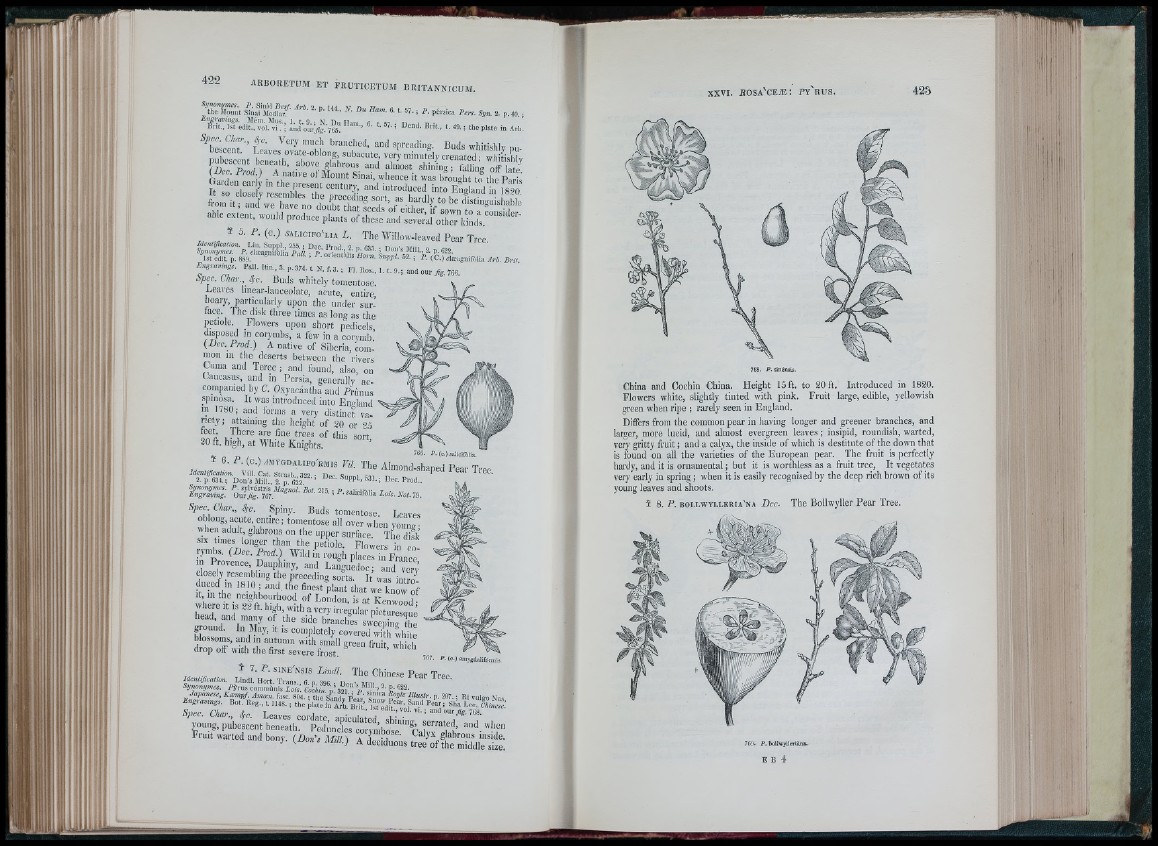
4 2 2 a r b o r e t u m e t FR U T IC E TUM B R ITA N N IC UM .
/ t h e áquÍÁ s r á u 'M r th íí f ' ’ 57. i P. pérsica Pers. St/n. 2. p .40. ;
racf’o u rj^ .V ? :! “■ '■ ” ■ ' “ ™‘'- « • ! ''■« P'““ i» Arb.
^ 7 7 (7 1 7 '’ 7 ' “ d spreading. Buds whitishlv m.
m ib e s fn t f e f e f h” n h '° j unesccnt beneath, abov e g1l®a;b rous and almost shinin®g‘'®; nfaatleldil i;« wohffi LI-h,tloy
{Uec Prod ) A native of M ount Sinai, whence it was b?ou« t to the F .i!
( a. den early m the present century, and introiluced into E¿« a ? in 82¿
s 5. P. ( c .) salicifo' lia L. The Willow-leaved F e a r Tree
p ,,i . p . , n ,
Spec. Char., f r . Buds whitely tomentose.
Leaies hnear-lanceolate, acute, entire
hoary, particularly upon the under sur-’
tace. Ih e disk three times as long as the
petiole. Flowers upon short pedicels,
disposed m corymbs, a few in a corymb
(Dec. P r o f ) A native of Siberia, common
in tlie deserts between the rivers
C.ima and Terec ; and found, also, on
(.-aucasus, and m Fersia, generally accompanied
by C. Oxyacàntha and Frfmus
spinosa. It was introduced into England
in 1780; and forms a very distinct v--
n e ty ; fttaining the Iieight of 20 or 25
teet. I here are fine trees of this sort
20 ft. high, at White Knights. ’
„ 7“ . P. (c.).allUaila.
, ^ • f o - ) / “ ''™ALiF0 'R „ ,s ru. The Almond-Shaped F e a r Tre e
¿ u / / ? 7OT Nel. 73.
fre e Char., f r . Spiny. Buds tomentose
oblong, acute, entire ; tomentose all over wh
when adult, glabrous on the upper surface
SIX times longer than the petiole. F I o /e r ! 'to
rymbs. {Dec. Prod.) Wild £ rough p t o t r i 1 F r a n c f
in Provence Dauphmy, and Languedoc; and ve?-v
closeW resembling the preceding sorts. It was intro
Leaves
;n young ;
T h e disk
drop oft with the first severe frost ’ '
/C7. K (c.)aniygda!ifóniiU
„ ®‘n e 'n s i s L m d l . Th e Clilnese P e a r Tre e
Identification. Lindl. Hort. Trans 6 d SQfi • -nr, - n fi.
Synonymes. P f ru s commùnis Lori. cT c h il r i 2- P- «22.
Japanese, Kcemp/. Amcen. fase. 804. ; the Sandv P pfr' Snlf*' IJlusir. p. 207. ; Ri vulgo Nas
Engrar,„gs. Hot. Ueg., t. 1148. ; th e ¡.late ¡ n i l bT; fa«<I P e a r; Sha Lee, K in c l '.
Fm ..,U ..a ^ ,“ %fS’3 l" S :
X X V I. b o s a ' c e ^ : p y ' r u s . 425
/ f ,
China and Cochin China. Height to ft, to 20ft. Introduced in 1820.
Flowers white, slightly tinted with pink. Fruit large, edible, yellowish
green when ripe ; rarely seen in England.
Differs from the common pear in having longer and greener branches, and
larger, more lucid, and almost evergreen leaves; insipid, roundish, warted,
very gritty fru it; and a calyx, the inside of which is destitute of the down that
is found on all the varieties of the European pear. The fruit is perfectly
hardy, and it is ornamental; but it is worthless as a fruit tree, It vegetates
very early in spring; when it is easily recognised by the deep rich brown of its
young leaves and shoots.
i 8. P. b o l l w v l l e r i a ' n a Dec. The Bollwyller Pear Tree.
76Í). F . bollwylleríln».
E E 4